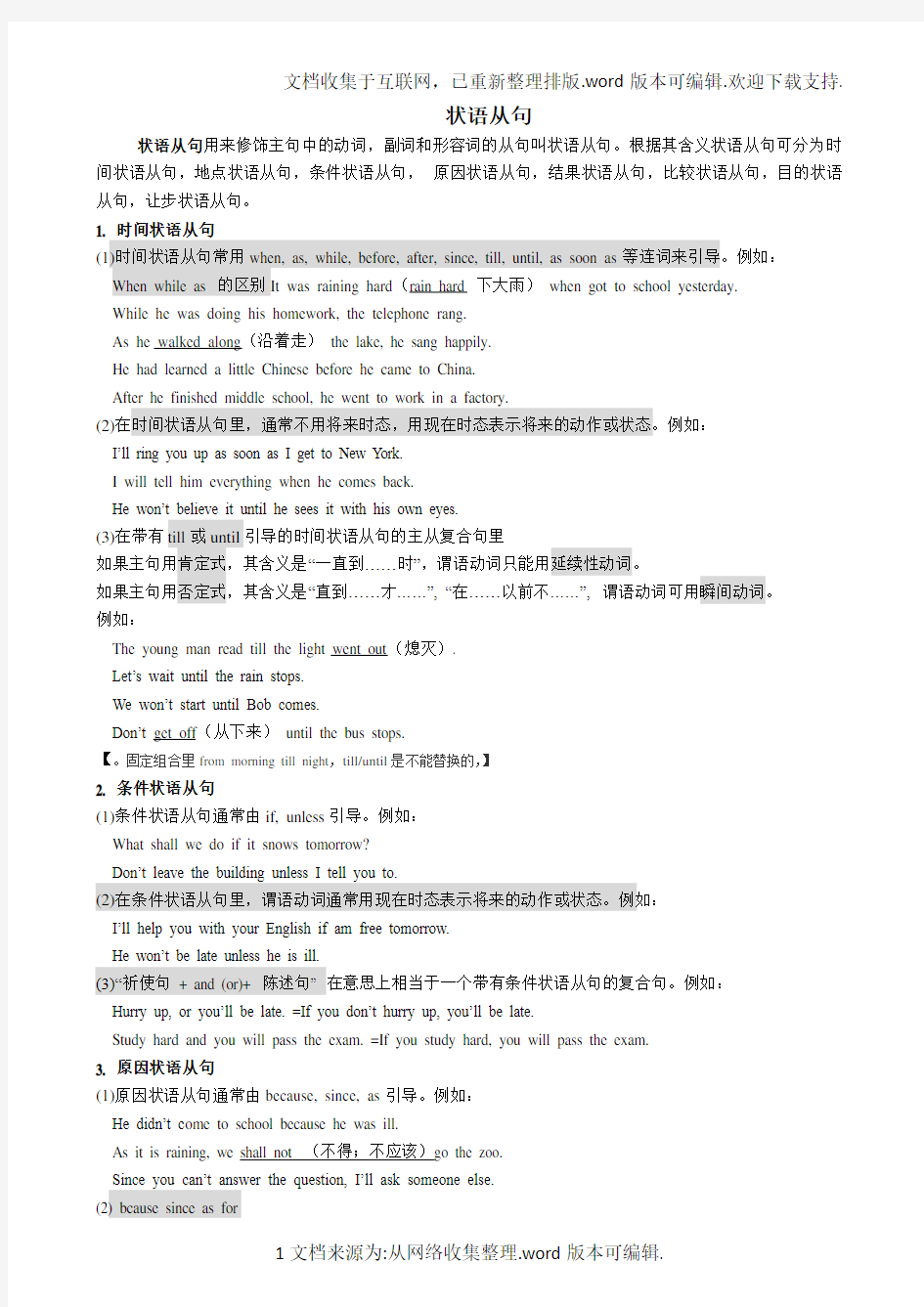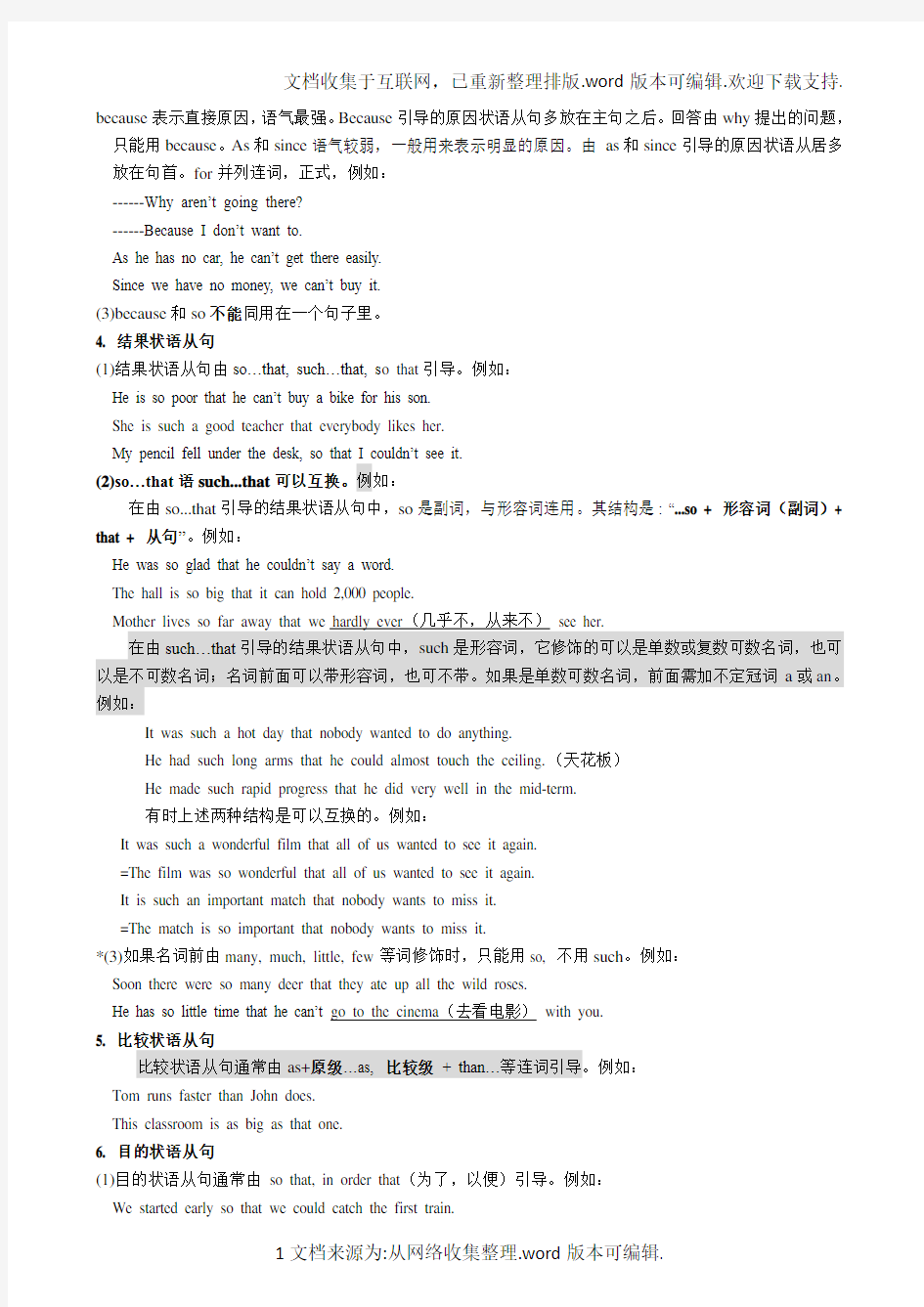

状语从句
状语从句用来修饰主句中的动词,副词和形容词的从句叫状语从句。根据其含义状语从句可分为时间状语从句,地点状语从句,条件状语从句,原因状语从句,结果状语从句,比较状语从句,目的状语从句,让步状语从句。
1. 时间状语从句
(1)时间状语从句常用when, as, while, before, after, since, till, until, as soon as等连词来引导。例如:
When while as 的区别It was raining hard(rain hard 下大雨)when got to school yesterday.
While he was doing his homework, the telephone rang.
As he walked along(沿着走)the lake, he sang happily.
He had learned a little Chinese before he came to China.
After he finished middle school, he went to work in a factory.
(2)在时间状语从句里,通常不用将来时态,用现在时态表示将来的动作或状态。例如:
I’ll ring you up as soon as I get to New York.
I will tell him everything when he comes back.
He won’t believe it until he sees it with his own eyes.
(3)在带有till或until引导的时间状语从句的主从复合句里
如果主句用肯定式,其含义是“一直到……时”,谓语动词只能用延续性动词。
如果主句用否定式,其含义是“直到……才……”, “在……以前不……”, 谓语动词可用瞬间动词。
例如:
The young man read till the light went out(熄灭).
Let’s wait until the rain stops.
We won’t start until Bob comes.
Don’t get off(从下来)until the bus stops.
【。固定组合里from morning till night,till/until是不能替换的,】
2. 条件状语从句
(1)条件状语从句通常由if, unless引导。例如:
What shall we do if it snows tomorrow?
Don’t leave the building unless I tell you to.
(2)在条件状语从句里,谓语动词通常用现在时态表示将来的动作或状态。例如:
I’ll help you with your English if am free tomorrow.
He won’t be late unless he is ill.
(3)“祈使句+ and (or)+ 陈述句” 在意思上相当于一个带有条件状语从句的复合句。例如:
Hurry up, or you’ll be late. =If you don’t hurry up, you’ll be late.
Study hard and you will pass the exam. =If you study hard, you will pass the exam.
3. 原因状语从句
(1)原因状语从句通常由because, since, as引导。例如:
He didn’t c ome to school because he was ill.
As it is raining, we shall not (不得;不应该)go the zoo.
Since you can’t answer the question, I’ll ask someone else.
(2) bcause since as for
because表示直接原因,语气最强。Because引导的原因状语从句多放在主句之后。回答由why提出的问题,只能用because。As和since语气较弱,一般用来表示明显的原因。由as和since引导的原因状语从居多放在句首。for并列连词,正式,例如:
------Why aren’t going there?
------Because I don’t want to.
As he has no car, he can’t get there easily.
Since we have no money, we can’t buy it.
(3)because和so不能同用在一个句子里。
4. 结果状语从句
(1)结果状语从句由so…that, such…that, s o that引导。例如:
He is so poor that he can’t buy a bike for his son.
She is such a good teacher that everybody likes her.
My pencil fell under the desk, so that I couldn’t see it.
(2)so…that语such...that可以互换。例如:
在由so...that引导的结果状语从句中,so是副词,与形容词连用。其结构是: “...so + 形容词(副词)+ that + 从句”。例如:
He was so glad that he couldn’t say a word.
The hall is so big that it can hold 2,000 people.
Mother lives so far away that we hardly ever(几乎不,从来不)see her.
在由such…that引导的结果状语从句中,such是形容词,它修饰的可以是单数或复数可数名词,也可以是不可数名词;名词前面可以带形容词,也可不带。如果是单数可数名词,前面需加不定冠词a或an。例如:
It was such a hot day that nobody wanted to do anything.
He had such long arms that he could almost touch the ceiling.(天花板)
He made such rapid progress that he did very well in the mid-term.
有时上述两种结构是可以互换的。例如:
It was such a wonderful film that all of us wanted to see it again.
=The film was so wonderful that all of us wanted to see it again.
It is such an important match that nobody wants to miss it.
=The match is so important that nobody wants to miss it.
*(3)如果名词前由many, much, little, few等词修饰时,只能用so, 不用such。例如:
Soon there were so many deer that they ate up all the wild roses.
He has so little time that he can’t go to the cinema(去看电影)with you.
5. 比较状语从句
比较状语从句通常由as+原级…as, 比较级+ than…等连词引导。例如:
Tom runs faster than John does.
This classroom is as big as that one.
6. 目的状语从句
(1)目的状语从句通常由so that, in order that(为了,以便)引导。例如:
We started early so that we could catch the first train.